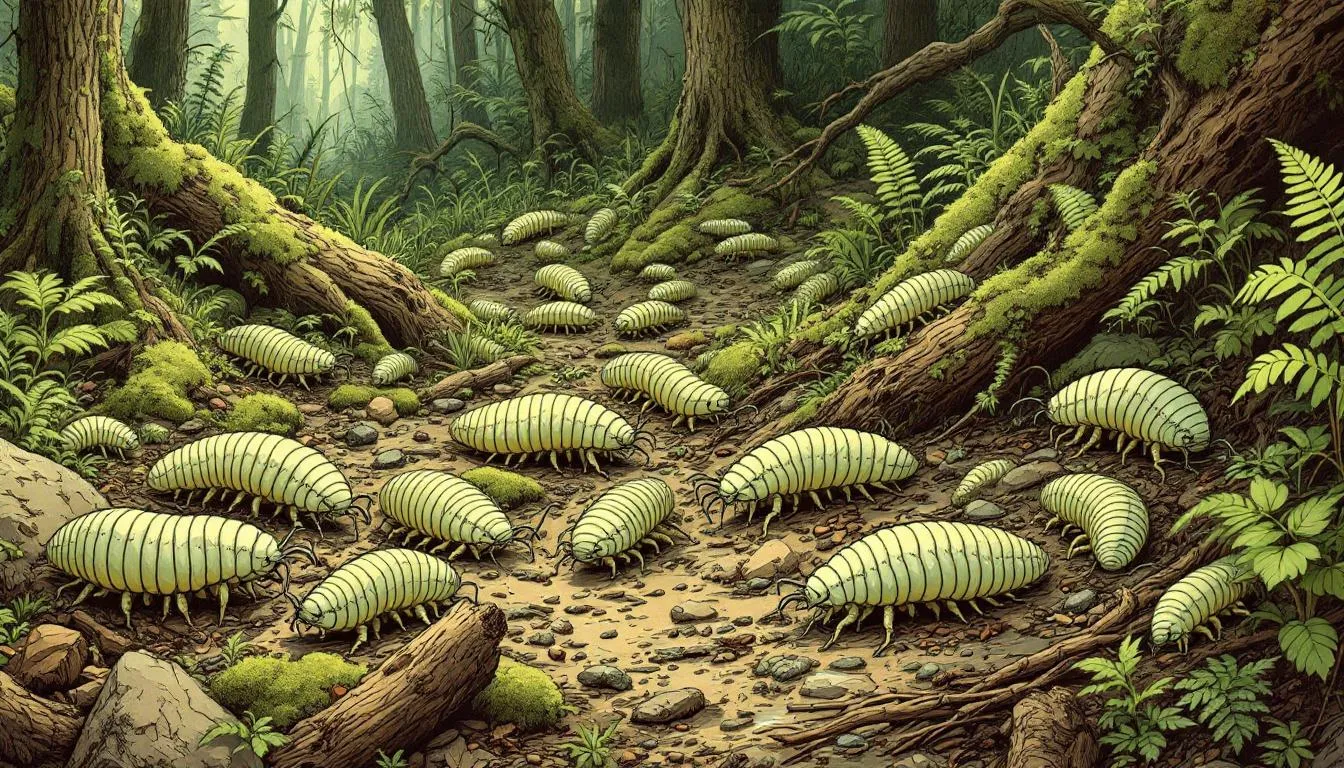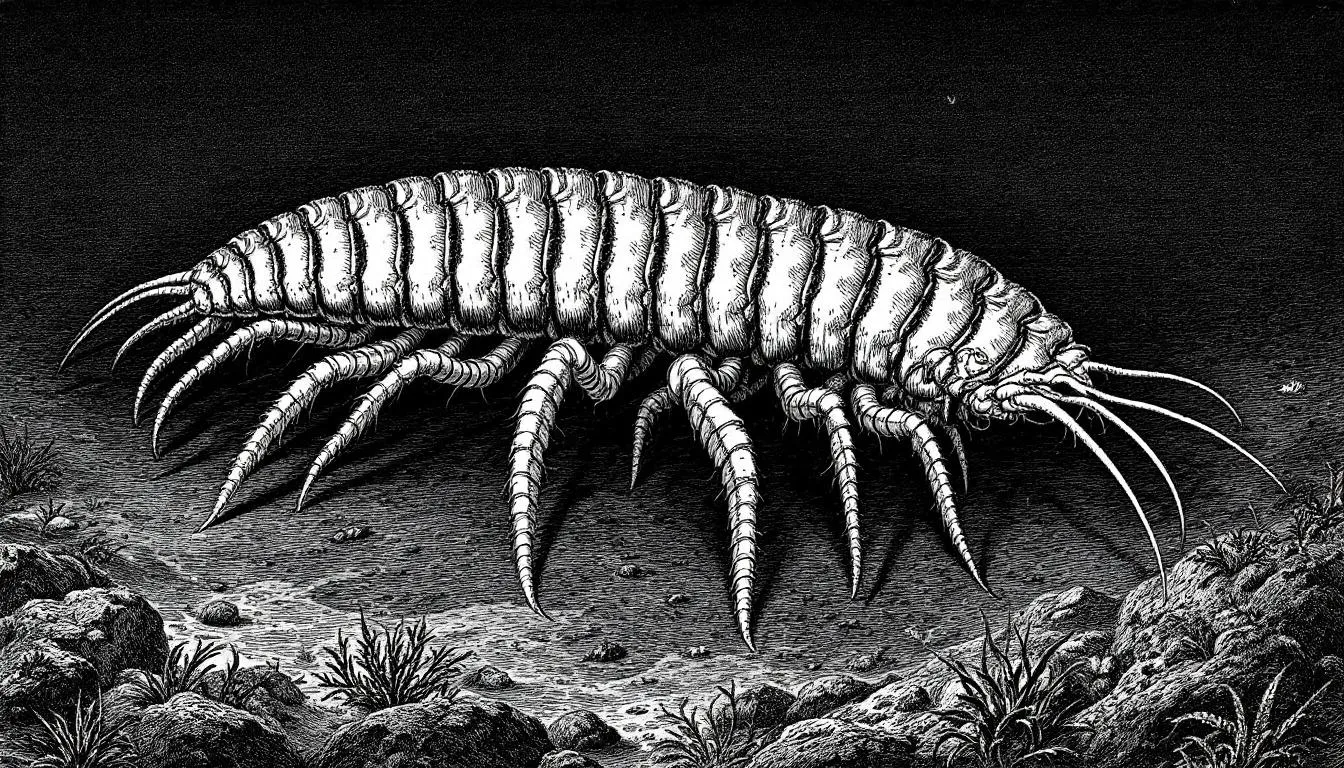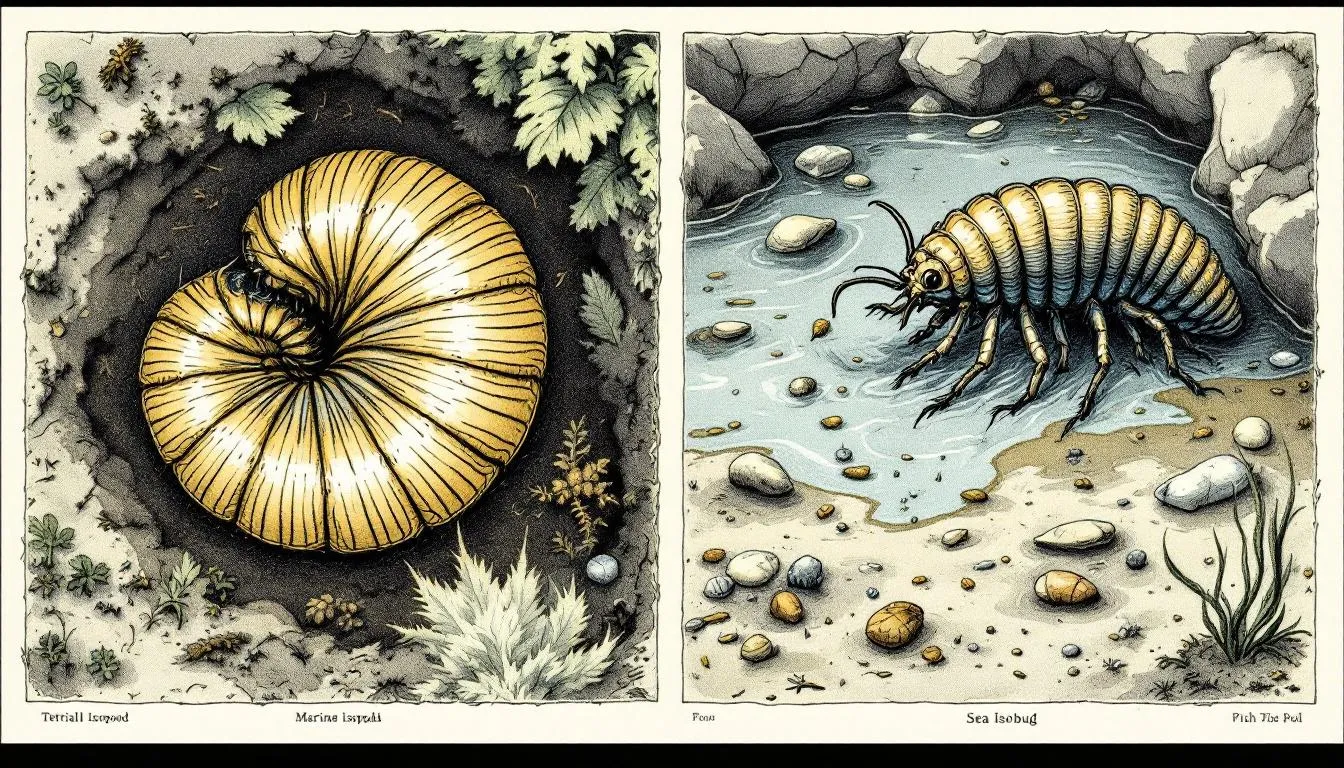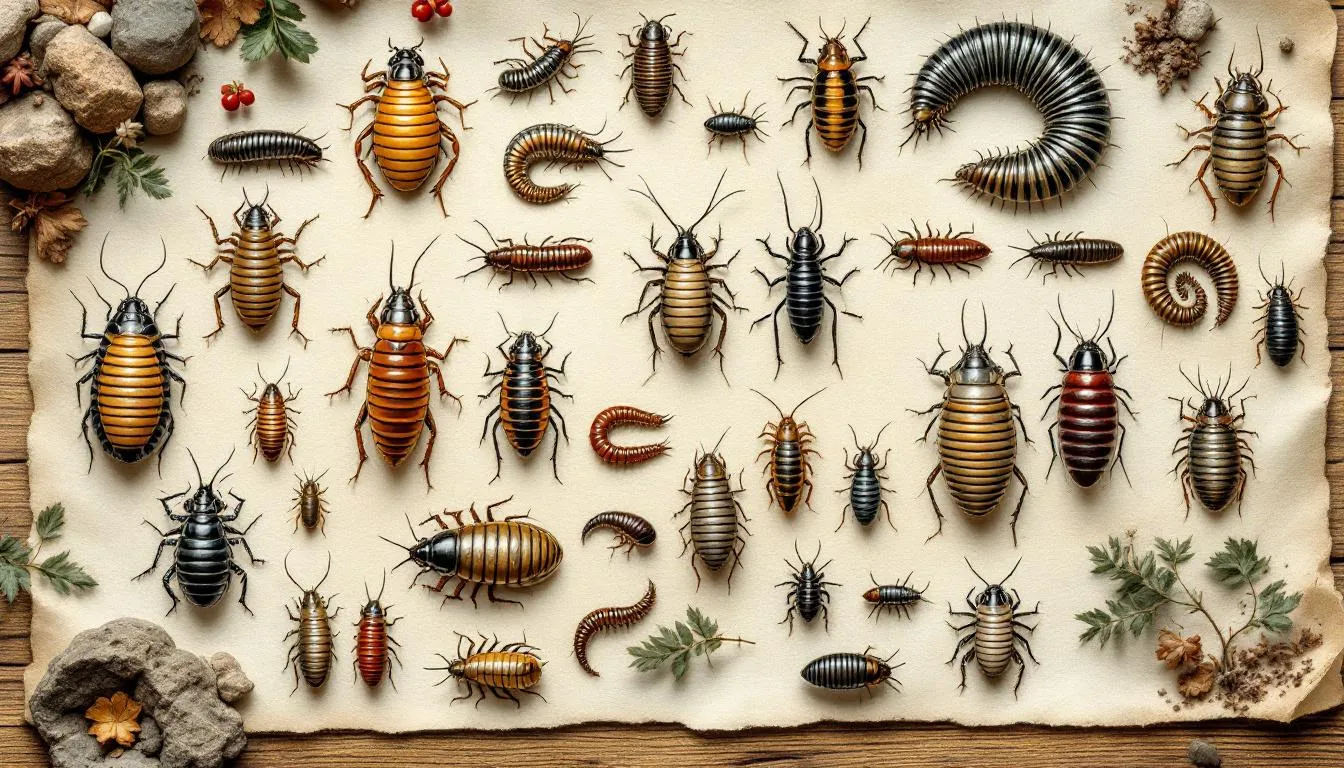An isopod is a type of crustacean found in various environments, from gardens to the deep sea. Known commonly as pillbugs or woodlice on land, these creatures play vital roles in nature. This guide explores what isopods are, their anatomy, lifecycle, and importance in ecosystems.
Key Takeaways
-
Isopods originated around 300 million years ago during the Carboniferous period and have since diversified into various terrestrial and marine species, showcasing their adaptability and evolutionary resilience.
-
They have distinctive anatomical features, including a segmented body with pleopods for gas exchange and long antennae for environmental sensing, enabling survival in diverse habitats.
-
Isopods play critical roles in ecosystems as decomposers and scavengers, contributing to nutrient cycling and ecological balance, and their conservation is essential for maintaining environmental health.
Ancient Origins of Isopods

The story of isopods begins in the depths of geological history. These fascinating creatures first emerged in the fossil record during the Carboniferous period, approximately 300 million years ago. Imagine a world dominated by vast swampy forests and gigantic insects, where the earliest isopods, primitive short-tailed organisms, thrived in marine environments. These ancient isopods laid the groundwork for a lineage that would diversify and adapt to a myriad of habitats over the millennia.
As the supercontinent Gondwana began to break apart, isopods evolved into various forms, showcasing the power of adaptive radiation. This evolutionary process led to a rich diversity of modern descendants, including both terrestrial and aquatic species. The long-tailed isopods, for instance, likely developed after this continental drift, spreading across different regions and adapting to new environments.
Today, the legacy of these ancient isopods is evident in the incredible variety of species we see. From the terrestrial species that inhabit our gardens to the giant deep-sea isopod that roams the ocean floor, isopods have truly mastered the art of survival and adaptation. Their journey through time is a testament to the resilience and versatility of life on Earth.
Anatomy of Isopods

The anatomy of isopods is a marvel of evolutionary engineering, perfectly suited to their diverse lifestyles. The body of an isopod is divided into two main sections: the pereon (thorax) and the pleon (abdomen). The pereon consists of seven segments, each equipped with a pair of legs, giving these creatures a total of seven pairs of legs for efficient movement across various terrains. The first segment of this segment structure provides flexibility and mobility, allowing isopods to navigate their environments with ease. Additionally, these isopods can be categorized into six segments based on their anatomical features.
One of the most intriguing features of isopods is their pleopods, gill-like structures located on the underside of the pleon. These pleopods facilitate gas exchange, essential for respiration in both aquatic and terrestrial species. Some terrestrial isopods have pseudo-trachea on their pleopods, enhancing their ability to absorb oxygen from the air and survive outside water. This adaptation enables them to thrive in moist terrestrial habitats.
Another distinctive feature of isopods is their long antennae, which are equipped with unique ends called isopods flagella. These antennae play a vital role in sensing their environment, helping isopods navigate, find food, and communicate with each other.
The intricate anatomy of isopods and other crustaceans showcases the remarkable adaptations that have allowed these animals to flourish in diverse ecosystems, from the depths of the ocean to our own backyards.
Life Cycle of Isopods
The life cycle of isopods is a journey of transformation and growth, encompassing four distinct stages:
-
Egg: Isopod eggs are typically laid in a protective environment, ensuring the safety and development of the embryos. These eggs are carefully guarded by the parent, often housed in a brood pouch until they are ready to hatch, providing a secure start to life.
-
Juvenile
-
Subadult
-
Adult
Upon hatching, juvenile isopods emerge, resembling smaller versions of adults but with simpler features. As they grow, these young isopods undergo several molts, shedding their exoskeleton to make way for new growth. This process allows them to develop more complex structures and gradually take on the characteristics of adult isopods. The juvenile stage is a critical period of growth and development for juveniles, where isopods refine their survival skills and adapt to their environment.
The final stages of the isopod life cycle involve the transition from subadult to adult. During this period, isopods undergo a moult process, shedding their exoskeleton to accommodate their increasing size and maturity.
Once fully developed, adult isopods possess full reproductive capabilities, marking the completion of their physical development. These adults continue the cycle, laying eggs and ensuring the continuation of their species, contributing to the dynamic and resilient populations of isopods we see today.
Terrestrial vs. Marine Isopods

Isopods have conquered both land and sea, showcasing a remarkable ability to adapt to diverse habitats. Terrestrial isopods, such as Armadillidium vulgare, commonly known as pillbugs, typically inhabit moist environments like leaf litter and under rocks. These terrestrial species thrive in deciduous woodlands, where the damp conditions provide the necessary moisture for their survival. Their ability to retain moisture through their segmented exoskeleton is a key adaptation that allows them to flourish in these environments.
In stark contrast, marine isopods, including the giant deep-sea isopod, have adapted to the extreme conditions of the deep sea. These giant isopods prefer muddy or clay substrates and are often found in the cold, deep waters of the Atlantic, Pacific, and Indian Oceans. Their pleopods function similarly to gills, facilitating gas exchange and allowing them to thrive underwater. The ability to survive in such harsh conditions highlights the incredible versatility of the isopod group.
The differences between terrestrial and marine isopods are a testament to the diverse evolutionary paths these creatures have taken. Whether burrowing in soil or scavenging the ocean floor, isopods have developed unique adaptations that enable them to exploit a wide range of ecological niches. This diversity underscores the resilience and adaptability of isopods, making them a fascinating subject of study for scientists and nature enthusiasts alike.
Importance of Isopods in Ecosystems

Isopods play a crucial role in maintaining the health and balance of ecosystems. Terrestrial isopods, such as woodlice, are essential decomposers, contributing in several ways:
-
Consuming decaying plant matter
-
Aiding in the return of nutrients to the soil
-
Supporting the process of decomposition and nutrient cycling, which is vital for soil health
-
Supporting the growth of plants and sustaining the broader ecosystem
-
Contributing to the fertility and productivity of terrestrial environments by breaking down organic matter
In marine ecosystems, giant isopods act as scavengers, consuming both live and decomposed marine organisms. Their scavenging behavior impacts deep-sea ecosystems by recycling nutrients and maintaining the balance of marine food webs. The largest isopod, Bathynomus giganteus, exemplifies the role of these creatures in deep-sea environments, where they help regulate the populations of other marine organisms and contribute to the overall health of the ecosystem.
Isopods serve important roles in environmental monitoring and ecosystem health:
-
They act as bioindicators for soil pollution, helping to assess the ecological impact of contaminants.
-
Their sensitivity to environmental changes makes them valuable for monitoring ecosystem health and detecting early signs of pollution.
-
Studying isopod populations enables scientists to gain insights into ecosystem health and implement protective measures for these vital habitats.
How Isopods Survive
Survival in diverse and sometimes harsh environments requires remarkable adaptations, and isopods have evolved several strategies to thrive. One of the key adaptations of terrestrial isopods is their ability to retain moisture through their segmented exoskeleton, which helps minimize water loss. High humidity levels between 70-80% are necessary for their health, which can be maintained by providing a moist substrate rich in organic materials like leaf litter.
Burrow behavior is another survival strategy exhibited by many isopod species, allowing them to find refuge and maintain the moisture necessary for their survival. Some terrestrial isopods have adaptations resembling lungs, enabling them to breathe air and survive outside aquatic environments. These adaptations are essential for their survival in terrestrial habitats, where maintaining moisture and avoiding desiccation are critical challenges.
Isopods also exhibit protective behaviors such as rolling into a ball, a mechanism that serves as a defense against predators and helps conserve moisture. Providing hiding spots with materials like cork bark and pieces of wood can create an environment that mimics their natural habitat, offering protection and maintaining the humidity levels they need.
These survival strategies highlight the resilience and adaptability of isopods, enabling them to thrive in a variety of environments.
Common Isopod Species

The world of isopods is incredibly diverse, with around 10,000 species discovered so far. Within the Isopoda order, approximately 3,500 species have been identified, each showcasing unique adaptations and characteristics. Among these, woodlice are a well-known group, with 37 species residing within the British Isles alone. Belonging to the class Crustacea, woodlice are a familiar sight in gardens and woodlands, playing a crucial role in decomposition and nutrient cycling.
One of the most fascinating groups within the isopod family is the genus Bathynomus, which includes the giant deep-sea isopod. The largest confirmed species, Bathynomus giganteus, can reach lengths between 19 and 36 cm and is found in the cold, deep waters of the Atlantic, Pacific, and Indian Oceans. These giant isopods are generally solitary and prefer muddy or clay substrates, showcasing their adaptation to extreme deep-sea conditions. Additionally, they are considered one of the large species of isopods.
Armadillidium vulgare, commonly known as the pillbug, is another notable species. Often found in moist environments like leaf litter and under rocks, pillbugs can roll into a ball for protection, showcasing the diversity within the isopod group.
The variety of isopod species and small species, along with other isopods, highlights the incredible adaptability and resilience of these creatures, making them a subject of endless fascination for scientists and nature enthusiasts alike.
Caring for Pet Isopods
Caring for pet isopods, such as woodlice, requires creating an environment that mimics their natural habitat. Key care requirements include:
-
High moisture environments with cool temperatures
-
Maintaining humidity levels between 70-80% by regularly misting the habitat
-
Providing a moist substrate rich in organic materials like leaf litter
These conditions help ensure the health and vitality of your pet isopods.
A balanced diet is crucial for isopod health. Regularly feeding them:
-
Fresh fruits
-
Vegetables
-
Specialized diets ensures they receive necessary nutrients for growth and development. Since isopods eat various organic matter, a diverse diet supports their nutritional needs and overall well-being.
Creating hiding spots with materials like cork bark and pieces of wood can offer protection and replicate the dark, damp environments that isopods prefer. Ensuring that the habitat is well-ventilated and free from contaminants is also important for maintaining a healthy environment for your pet isopods. By understanding and meeting their needs, you can enjoy the fascinating behaviors and unique characteristics of these remarkable creatures.
How You Can Help Isopods
Contributing to the conservation and study of isopods can have a significant impact on their populations and the ecosystems they inhabit. Participating in citizen science projects allows individuals to contribute to the monitoring of isopod populations and their health. Reporting sightings of isopods can provide valuable data for scientists studying their distribution and health. For instance, the Blue Woodlice Detective project specifically targets monitoring diseases affecting woodlice, which can be detrimental to their colonies.
Creating isopod-friendly environments involves maintaining natural habitats that support their populations and well-being. This can include maintaining moisture and organic matter in gardens, which enhances their habitats and supports their ecological roles. Promoting practices that support isopod health helps ensure the survival and flourishing of these vital creatures.
Isopods are an integral part of our ecosystems, and their conservation is crucial for maintaining ecological balance. By participating in conservation efforts and creating supportive environments, we can help protect these fascinating creatures and the important roles they play in our natural world.
Summary
Isopods, with their ancient origins, intricate anatomy, and diverse habitats, are a testament to the resilience and adaptability of life. From their role in nutrient cycling and decomposition to their unique survival strategies, isopods contribute significantly to the health and balance of ecosystems. Understanding their life cycle and ecological importance not only enriches our knowledge but also highlights the need for their conservation.
As we continue to explore and appreciate the world of isopods, let us also take steps to protect and support these remarkable creatures. By creating isopod-friendly environments and participating in conservation efforts, we can ensure that isopods continue to thrive and play their crucial roles in our natural world. Let the story of isopods inspire us to cherish and protect the incredible diversity of life on Earth.
Frequently Asked Questions
When did isopods first appear in the fossil record?** **?
Isopods first appeared in the fossil record during the Carboniferous period, around 300 million years ago. This marks a significant point in the evolutionary history of these versatile crustaceans.
What are the main differences between terrestrial and marine isopods?** **?
The main differences between terrestrial and marine isopods lie in their habitats and adaptations; terrestrial isopods thrive in moist environments, while marine isopods are specialized for deep-sea conditions. This distinction highlights their evolutionary adaptations to diverse environments.
How do isopods contribute to ecosystem health?** **?
Isopods significantly contribute to ecosystem health by promoting decomposition, enhancing nutrient cycling as scavengers, and acting as bioindicators for soil pollution, thereby providing insights into environmental conditions. Their presence reflects the overall well-being of the ecosystem.
What do pet isopods need to thrive?** **?
To thrive, pet isopods need a high-moisture environment with cool temperatures, a balanced diet including fresh fruits and vegetables, and adequate hiding spots using materials like cork bark and wood. Ensuring these conditions will promote their health and well-being.
How can individuals help in the conservation of isopods?** **?
Individuals can significantly aid in isopod conservation by engaging in citizen science initiatives and ensuring their gardening practices support moisture retention and organic matter. This active involvement promotes healthy habitats for these important organisms.









